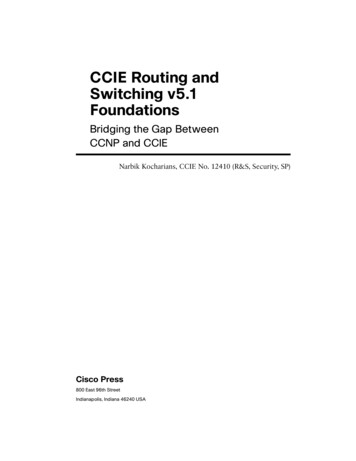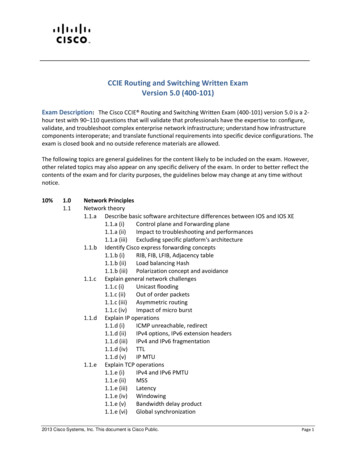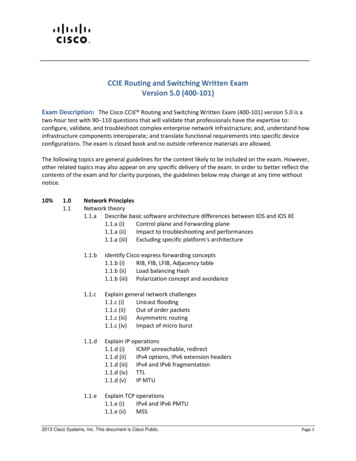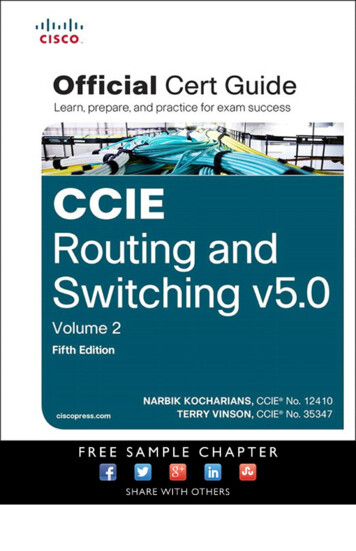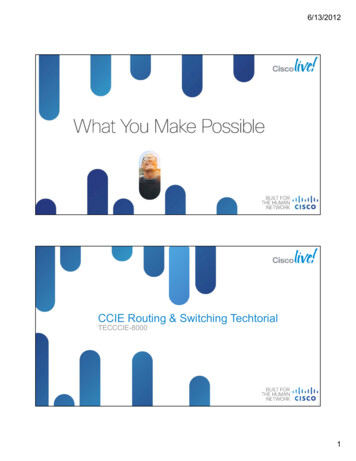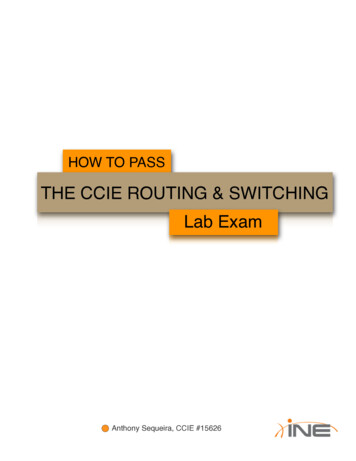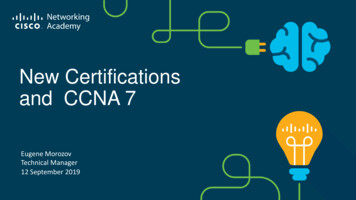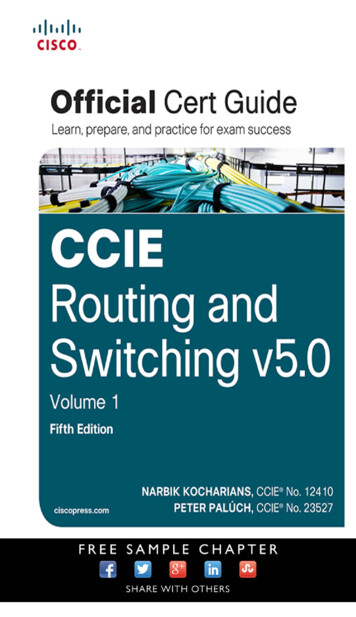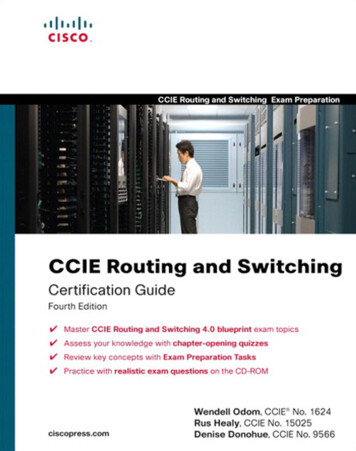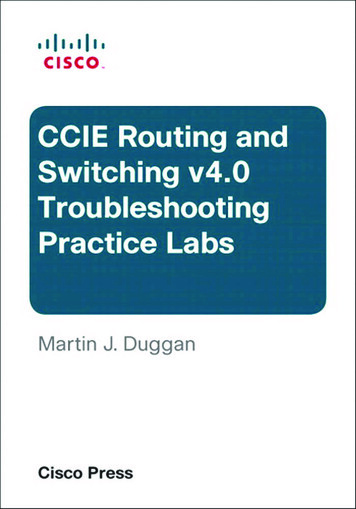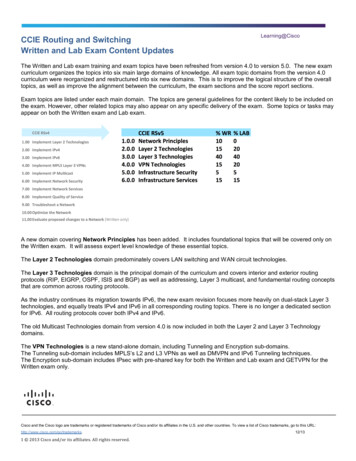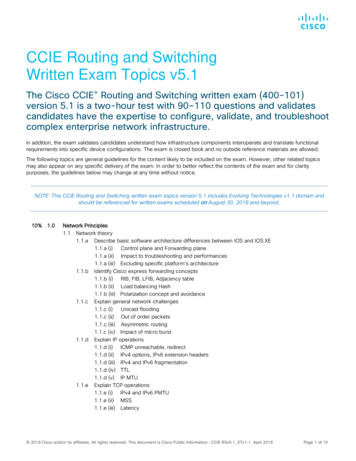
Transcription
CCIE Routing and SwitchingWritten Exam Topics v5.1The Cisco CCIE Routing and Switching written exam (400-101)version 5.1 is a two-hour test with 90 110 questions and validatescandidates have the expertise to configure, validate, and troubleshootcomplex enterprise network infrastructure.PPIn addition, the exam validates candidates understand how infrastructure components interoperate and translate functionalrequirements into specific device configurations. The exam is closed book and no outside reference materials are allowed.The following topics are general guidelines for the content likely to be included on the exam. However, other related topicsmay also appear on any specific delivery of the exam. In order to better reflect the contents of the exam and for claritypurposes, the guidelines below may change at any time without notice.NOTE: This CCIE Routing and Switching written exam topics version 5.1 includes Evolving Technologies v1.1 domain andshould be referenced for written exams scheduled on August 30, 2018 and beyond.10% 1.0Network Principles1.1 Network theory1.1.a Describe basic software architecture differences between IOS and IOS XE1.1.a (i)Control plane and Forwarding plane1.1.a (ii) Impact to troubleshooting and performances1.1.a (iii) Excluding specific platform's architecture1.1.b Identify Cisco express forwarding concepts1.1.b (i) RIB, FIB, LFIB, Adjacency table1.1.b (ii) Load balancing Hash1.1 b (iii) Polarization concept and avoidance1.1.c Explain general network challenges1.1.c (i)Unicast flooding1.1.c (ii) Out of order packets1.1.c (iii) Asymmetric routing1.1.c (iv) Impact of micro burst1.1.d Explain IP operations1.1.d (i) ICMP unreachable, redirect1.1.d (ii) IPv4 options, IPv6 extension headers1.1.d (iii) IPv4 and IPv6 fragmentation1.1.d (iv) TTL1.1.d (v) IP MTU1.1.e Explain TCP operations1.1.e (i) IPv4 and IPv6 PMTU1.1.e (ii) MSS1.1.e (iii) Latency 2018 Cisco and/or its affiliates. All rights reserved. This document is Cisco Public Information. CCIE RSv5.1 ETv1.1 April 2018Page 1 of 10
CCIE Routing and Switching Written Exam Topics v5.11.21.313% 2.01.1.e (iv) Windowing1.1.e (v) Bandwidth delay product1.1.e (vi) Global synchronization1.1.e (vii) Options1.1.f Explain UDP operations1.1.f (i)Starvation1.1.f (ii)Latency1.1.f (iii) RTP/RTCP conceptsNetwork implementation and operation1.2.a Evaluate proposed changes to a network1.2.a (i)Changes to routing protocol parameters1.2.a (ii) Migrate parts of a network to IPv61.2.a (iii) Routing protocol migration1.2.a (iv) Adding multicast support1.2.a (v) Migrate spanning tree protocol1.2.a (vi) Evaluate impact of new traffic on existing QoS designNetwork troubleshooting1.3.a Use IOS troubleshooting tools1.3.a (i)debug, conditional debug1.3.a (ii) ping, traceroute with extended options1.3.a (iii) Embedded packet capture1.3.a (iv) Performance monitor1.3.b Apply troubleshooting methodologies1.3.b (i) Diagnose the root cause of networking issue (analyze symptoms, identify anddescribe root cause)1.3.b (ii) Design and implement valid solutions according to constraints1.3.b (iii) Verify and monitor resolution1.3.c Interpret packet capture1.3.c (i) Using Wireshark trace analyzer1.3.c (ii) Using IOS embedded packet captureLayer 2 Technologies2.1 LAN switching technologies2.1.a Implement and troubleshoot switch administration2.1.a (i)Managing MAC address table2.1.a (ii) errdisable recovery2.1.a (iii) L2 MTU2.1.b Implement and troubleshoot layer 2 protocols2.1.b (i) CDP, LLDP2.1.b (ii) UDLD2.1.c Implement and troubleshoot VLAN2.1.c (i) Access ports2.1.c (ii) VLAN database2.1.c (iii) Normal, extended VLAN, voice VLAN2.1.d Implement and troubleshoot trunking2.1.d (i) VTPv1, VTPv2, VTPv3, VTP pruning2.1.d (ii) dot1Q2.1.d (iii) Native VLAN 2018 Cisco and/or its affiliates. All rights reserved. This document is Cisco Public Information. CCIE RSv5.1 ETv1.1 April 2018Page 2 of 10
CCIE Routing and Switching Written Exam Topics v5.12.1.d (iv) Manual pruning2.1.e Implement and troubleshoot EtherChannel2.1.e (i) LACP, PAgP, manual2.1.e (ii) Layer 2, layer 32.1.e (iii) Load‐balancing2.1.e (iv) Etherchannel misconfiguration guard2.1.f Implement and troubleshoot spanning‐tree2.1.f (i)PVST /RPVST /MST2.1.f (ii)Switch priority, port priority, path cost, STP timers2.1.f (iii) port fast, BPDUguard, BPDUfilter2.1.f (iv) loopguard, rootguard2.1.g Implement and troubleshoot other LAN switching technologies2.1.g (i) SPAN, RS2PAN, ERSPAN2.1.h Describe chassis virtualization and aggregation technologies2.1.h (i) Multichassis2.1.h (ii) VSS concepts2.1.h (iii) Alternative to STP2.1.h (iv) Stackwise2.1.h (v) Excluding specific platform implementation2.1.iDescribe spanning‐tree concepts2.1.i (i)Compatibility between MST and RSTP2.1.i (ii)STP dispute, STP bridge assurance2.2 Layer 2 multicast2.2.a Implement and troubleshoot IGMP2.2.a (i)IGMPv1, IGMPv2, IGMPv32.2.a (ii) IGMP snooping2.2.a (iii) IGMP querier2.2.a (iv) IGMP filter2.2.a (v) IGMP proxy2.2.b Explain MLD2.2.c Explain PIM snooping2.3 Layer 2 WAN circuit technologies2.3.a Implement and troubleshoot HDLC2.3.b Implement and troubleshoot PPP2.3.b (i) Authentication (PAP, CHAP)2.3.b (ii) PPPoE2.3.b (iii) MLPPP2.3.c Describe WAN rate‐based ethernet circuits2.3.c (i) Metro and WAN Ethernet topologies2.3.c (ii) Use of rate‐limited WAN ethernet services37% 3.0Layer 3 Technologies3.1 Addressing technologies3.1.a Identify, implement and troubleshoot IPv4 addressing and subnetting3.1.a (i)Address types, VLSM3.1.a (ii) ARP3.1.b Identify, implement and troubleshoot IPv6 addressing and subnetting3.1.b (i) Unicast, multicast 2018 Cisco and/or its affiliates. All rights reserved. This document is Cisco Public Information. CCIE RSv5.1 ETv1.1 April 2018Page 3 of 10
CCIE Routing and Switching Written Exam Topics v5.13.23.33.1.b (ii) EUI‐643.1.b (iii) ND, RS/RA3.1.b (iv) Autoconfig/SLAAC, temporary addresses (RFC4941)3.1.b (v) Global prefix configuration feature3.1.b (vi) DHCP protocol operations3.1.b (vii) SLAAC/DHCPv6 interaction3.1.b (viii) Stateful, stateless DHCPv63.1.b (ix) DHCPv6 prefix delegationLayer 3 multicast3.2.a Troubleshoot reverse path forwarding3.2.a (i)RPF failure3.2.a (ii) RPF failure with tunnel interface3.2.b Implement and troubleshoot IPv4 protocol independent multicast3.2.b (i) PIM dense mode, sparse mode, sparse‐dense mode3.2.b (ii) Static RP, auto‐RP, BSR3.2.b (iii) BiDirectional PIM3.2.b (iv) Source‐specific multicast3.2.b (v) Group to RP mapping3.2.b (vi) Multicast boundary3.2.c Implement and troubleshoot multicast source discovery protocol3.2.c (i) Intra‐domain MSDP (anycast RP)3.2.c (ii) SA filter3.2.d Describe IPv6 multicast3.2.d (i) IPv6 multicast addresses3.2.d (ii) PIMv6Fundamental routing concepts3.3.a Implement and troubleshoot static routing3.3.b Implement and troubleshoot default routing3.3.c Compare routing protocol types3.3.c (i) Distance vector3.3.c (ii) Link state3.3.c (iii) Path vector3.3.d Implement, optimize and troubleshoot administrative distance3.3.e Implement and troubleshoot passive interface3.3.f Implement and troubleshoot VRF lite3.3.g Implement, optimize and troubleshoot filtering with any routing protocol3.3.h Implement, optimize and troubleshoot redistribution between any routing protocol3.3.i Implement, optimize and troubleshoot manual and auto summarization with any routingprotocol3.3.j Implement, optimize and troubleshoot policy‐based routing3.3.k Identify and troubleshoot sub‐optimal routing3.3.l Implement and troubleshoot bidirectional forwarding detection3.3.m Implement and troubleshoot loop prevention mechanisms3.3.m (i) Route tagging, filtering3.3.m (ii) Split horizon3.3.m (iii) Route poisoning3.3.n Implement and troubleshoot routing protocol authentication3.3.n (i) MD5 2018 Cisco and/or its affiliates. All rights reserved. This document is Cisco Public Information. CCIE RSv5.1 ETv1.1 April 2018Page 4 of 10
CCIE Routing and Switching Written Exam Topics v5.13.43.53.63.3.n (ii) Key‐chain3.3.n (iii) EIGRP HMAC SHA2‐256bit3.3.n (iv) OSPFv2 SHA1‐196bit3.3.n (v) OSPFv3 IPsec authenticationRIP (v2 and v6)3.4.a Implement and troubleshoot RIPv23.4.b Describe RIPv6 (RIPng)EIGRP (for IPv4 and IPv6)3.5.a Describe packet types3.5.a (i)Packet types (hello, query, update, and such)3.5.a (ii) Route types (internal, external)3.5.b Implement and troubleshoot neighbor relationship3.5.b (i) Multicast, unicast EIGRP peering3.5.b (ii) OTP point‐to‐point peering3.5.b (iii) OTP route‐reflector peering3.5.b (iv) OTP multiple service providers scenario3.5.c Implement and troubleshoot loop free path selection3.5.c (i) RD, FD, FC, successor, feasible successor3.5.c (ii) Classic metric3.5.c (iii) Wide metric3.5.d Implement and troubleshoot operations3.5.d (i) General operations3.5.d (ii) Topology table, update, query, active, passive3.5.d (iii) Stuck in active3.5.d (iv) Graceful shutdown3.5.e Implement and troubleshoot EIGRP stub3.5.e (i) Stub3.5.e (ii) Leak‐map3.5.f Implement and troubleshoot load‐balancing3.5.f (i)equal‐cost3.5.f (ii)unequal‐cost3.5.f (iii) add‐path3.5.g Implement EIGRP (multi‐address) named mode3.5.g (i) Types of families3.5.g (ii) IPv4 address‐family3.5.g (iii) IPv6 address‐family3.5.h Implement, troubleshoot and optimize EIGRP convergence and scalability3.5.h (i) Describe fast convergence requirements3.5.h (ii) Control query boundaries3.5.h (iii) IP FRR/fast reroute (single hop)3.5.8 (iv) Summary leak‐map3.5.h (v) Summary metricOSPF (v2 and v3)3.6.a Describe packet types3.6.a (i)LSA yypes (1, 2, 3, 4, 5, 7, 9)3.6.a (ii)Route types (N1, N2, E1, E2)3.6.b Implement and troubleshoot neighbor relationship3.6.c Implement and troubleshoot OSPFv3 address‐family support 2018 Cisco and/or its affiliates. All rights reserved. This document is Cisco Public Information. CCIE RSv5.1 ETv1.1 April 2018Page 5 of 10
CCIE Routing and Switching Written Exam Topics 3.7.e3.7.f3.7.g3.7.h3.6.c (i) IPv4 address‐family3.6.c (ii) IPv6 address‐familyImplement and troubleshoot network types, area types and router types3.6.d (i) Point‐to‐point, multipoint, broadcast, non‐broadcast3.6.d (ii) LSA types, area type: backbone, normal, transit, stub, NSSA, totally stub3.6.d (iii) Internal router, ABR, ASBR3.6.d (iv) Virtual linkImplement and troubleshoot path preferenceImplement and troubleshoot operations3.6.f (i)General operations3.6.f (ii)Graceful shutdown3.6.f (iii) GTSM (Generic TTL Security Mechanism)Implement, troubleshoot and optimize OSPF convergence and scalability3.6.g (i) Metrics3.6.g (ii) LSA throttling, SPF tuning, fast hello3.6.g (iii) LSA propagation control (area types, ISPF)3.6.g (iv) IP FRR/fast reroute (single hop)3.6.g (v) LFA/loop‐free alternative (multi hop)3.6.g (vi) OSPFv3 prefix suppressionDescribe, implement and troubleshoot peer relationships3.7.a (i)Peer‐group, template3.7.a (ii) Active, passive3.7.a (iii) States, timers3.7.a (iv) Dynamic neighborsImplement and troubleshoot IBGP and EBGP3.7.b (i) EBGP, IBGP3.7.b (ii) 4 bytes AS number3.7.b (iii) Private ASExplain attributes and best‐path selectionImplement, optimize and troubleshoot routing policies3.7.d (i) Attribute manipulation3.7.d (ii) Conditional advertisement3.7.d (iii) Outbound route filtering3.7.d (iv) Communities, extended communities3.7.d (v) Multi‐homingImplement and troubleshoot scalability3.7.e (i) Route‐reflector, cluster3.7.e (ii) ConfederationsImplement and troubleshoot multiproctocol BGP3.7.f (i)IPv4, IPv6, VPN address‐familyImplement and troubleshoot AS path manipulations3.7.g (i) Local AS, allow AS in, remove private AS3.7.g (ii) Prepend3.7.g (iii) RegexpImplement and troubleshoot other features3.7.h (i) Multipath3.7.h (ii) BGP synchronization 2018 Cisco and/or its affiliates. All rights reserved. This document is Cisco Public Information. CCIE RSv5.1 ETv1.1 April 2018Page 6 of 10
CCIE Routing and Switching Written Exam Topics v5.13.813%4.03.7.h (iii) Soft reconfiguration, route refresh3.7.i Describe BGP fast convergence features3.7.i (i)Prefix independent convergence3.7.i (ii)Add‐path3.7.i (iii) Next‐hop address trackingISIS (for IPv4 and IPv6)3.8.a Describe basic ISIS network3.8.a (i) Single area, single topology3.8.b Describe neighbor relationship3.8.c Describe network types, levels and router types3.8.c (i) NSAP addressing3.c.c (ii) Point‐to‐point, broadcast3.8.d Describe operations3.8.e Describe optimization features3.8.e (i) Metrics, wide metricVPN Technologies4.1 Tunneling4.1.a Implement and troubleshoot MPLS operations4.1.a (i)Label stack, LSR, LSP4.1.a (ii) LDP4.1.a (iii) MPLS ping, MPLS traceroute4.1.b Implement and troubleshoot basic MPLS L3VPN4.1.b (i) L3VPN, CE, PE, P4.1.b (ii) Extranet (route leaking)4.1.c Implement and troubleshoot encapsulation4.1.c (i) GRE4.1.c (ii) Dynamic GRE4.1.c (iii) LISP encapsulation principles supporting EIGRP OTP4.1.d Implement and troubleshoot DMVPN (single hub)4.1.d (i) NHRP4.1.d (ii) DMVPN with IPsec using preshared key4.1.d (iii) QoS profile4.1.d (iv) Pre‐classify4.1.e Describe IPv6 tunneling techniques4.1.e (i) 6in4, 6to44.1.e (ii) ISATAP4.1.e (iii) 6RD4.1.e (iv) 6PE/6VPE4.1.f Describe basic layer 2 VPN —wireline4.1.f (i)L2TPv3 general principals4.1.f (ii)ATOM general principals4.1.g Describe basic L2VPN — LAN services4.1.g (i) MPLS‐VPLS general principals4.1.g (ii) OTV general principals4.2 Encryption4.2.a Implement and troubleshoot IPsec with preshared key4.2.a (i)IPv4 site to IPv4 site 2018 Cisco and/or its affiliates. All rights reserved. This document is Cisco Public Information. CCIE RSv5.1 ETv1.1 April 2018Page 7 of 10
CCIE Routing and Switching Written Exam Topics v5.14.2.b5%12%5.06.04.2.a (ii) IPv6 in IPv4 tunnels4.2.a (iii) Virtual tunneling Interface (VTI)Describe GET VPNInfrastructure Security5.1 Device security5.1.a Implement and troubleshoot IOS AAA using local database5.1.b Implement and troubleshoot device access control5.1.b (i) Lines (VTY, AUX, console)5.1.b (ii) SNMP5.1.b (iii) Management plane protection5.1.b (iv) Password encryption5.1.c Implement and troubleshoot control plane policing5.1.d Describe device security using IOS AAA with TACACS and RADIUS5.1.d (i) AAA with TACACS and RADIUS5.1.d (ii) Local privilege authorization fallback5.2 Network security5.2.a Implement and troubleshoot switch security features5.2.a (i)VACL, PACL5.2.a (ii) Stormcontrol5.2.a (iii) DHCP snooping5.2.a (iv) IP source‐guard5.2.a (v) Dynamic ARP inspection5.2.a (vi) port‐security5.2.a (vii) Private VLAN5.2.b Implement and troubleshoot router security features5.2.b (i) IPv4 access control lists (standard, extended, time‐based)5.2.b (ii) IPv6 traffic filter5.2.b (iii) Unicast reverse path forwarding5.2.c Implement and troubleshoot IPv6 first hop security5.2.c (i) RA guard5.2.c (ii) DHCP guard5.2.c (iii) Binding table5.2.c (iv) Device tracking5.2.c (v) ND inspection/snooping5.2.c (vi) Source guard5.2.c (vii) PACL5.2.d Describe 802.1x5.2.d (i) 802.1x, EAP, RADIUS5.2.d (ii) MAC authentication bypassInfrastructure Services6.1 System management6.1.a Implement and troubleshoot device management6.1.a (i)Console and VTY6.1.a (ii) telnet, HTTP, HTTPS, SSH, SCP6.1.a (iii) (T)FTP6.1.b Implement and troubleshoot SNMP 2018 Cisco and/or its affiliates. All rights reserved. This document is Cisco Public Information. CCIE RSv5.1 ETv1.1 April 2018Page 8 of 10
CCIE Routing and Switching Written Exam Topics v5.16.26.36.46.1.b (i) v2c, v36.1.c Implement and troubleshoot logging6.1.c (i) Local logging, syslog, debug, conditional debug6.1.c (ii) TimestampQuality of service6.2.a Implement and troubleshoot end‐to‐end QoS6.2.a (i) CoS and DSCP mapping6.2.b Implement, optimize and troubleshoot QoS using MQC6.2.b (i) Classification6.2.b (ii) Network based application recognition (NBAR)6.2.b (iii) Marking using IP precedence, DSCP, CoS, ECN6.2.b (iv) Policing, shaping6.2.b (v) Congestion management (queuing)6.2.b (vi) HQoS, sub‐rate ethernet link6.1.b (vii) Congestion avoidance (WRED)6.2.c Describe layer 2 QoS6.2.c (i) Queuing, scheduling6.2.c (ii) Classification, markingNetwork services6.3.a Implement and troubleshoot first‐hop redundancy protocols6.3.a (i)HSRP, GLBP, VRRP6.3.a (ii) Redundancy using IPv6 RS/RA6.3.b Implement and troubleshoot network time protocol6.3.b (i) NTP master, client, version 3, version 46.3.b (ii)NTP Authentication6.3.c Implement and troubleshoot IPv4 and IPv6 DHCP6.3.c (i) DHCP client, IOS DHCP server, DHCP relay6.3.c (ii) DHCP options6.3.c (iii) DHCP protocol operations6.3.c (iv) SLAAC/DHCPv6 interaction6.3.c (v) Stateful, stateless DHCPv66.3.c (vi) DHCPv6 prefix delegation6.3.d Implement and troubleshoot IPv4 network address translation6.3.d (i) Static NAT, dynamic NAT, policy‐based NAT, PAT6.3.d (ii) NAT ALG6.3.e Describe IPv6 network address translation6.3.e (i) NAT646.3.e (ii) NPTv6Network optimization6.4.a Implement and troubleshoot IP SLA6.4.a (i) ICMP, UDP, Jitter, VoIP6.4.b Implement and troubleshoot tracking object6.4.b (i) Tracking object, tracking list6.4.b (ii) Tracking different entities (e.g. interfaces, routes, IPSLA, and such)6.4.c Implement and troubleshoot netflow6.4.c (i) Netflow v5, v96.4.c (ii) Local retrieval6.4.c (iii) Export (configuration only) 2018 Cisco and/or its affiliates. All rights reserved. This document is Cisco Public Information. CCIE RSv5.1 ETv1.1 April 2018Page 9 of 10
CCIE Routing and Switching Written Exam Topics v5.16.4.d6.4.e10% 7.0Implement and troubleshoot embedded event manager6.4.d (i) EEM policy using appletIdentify performance routing (PfR)6.4.e (i) Basic load balancing6.4.e (ii) Voice optimizationEvolving Technologies v1.17.1 Cloud7.1.a Compare and contrast public, private, hybrid, and multicloud design considerations7.1.a (i) Infrastructure, platform, and software as a service (XaaS)7.1.a (ii) Performance, scalability, and high availability7.1.a (iii) Security implications, compliance, and policy7.1.a (iv) Workload migration7.1.b Describe cloud infrastructure and operations7.1.b (i) Compute virtualization (containers and virtual machines)7.1.b (ii) Connectivity (virtual switches, SD-WAN and SD-Access)7.1.b (iii) Virtualization functions (NFVi, VNF, and L4/L7)7.1.b (iv) Automation and orchestration tools (CloudCenter, DNA-center, and Kubernetes)7.2 Network programmability (SDN)7.2.a Describe architectural and operational considerations for a programmable network7.2.a (i) Data models and structures (YANG, JSON and XML)7.2.a (ii) Device programmability (gRPC, NETCONF and RESTCONF)7.2.a (iii) Controller based network design (policy driven configuration and northbound/southbound APIs)7.2.a (iv) Configuration management tools (agent and agentless) and version control systems(Git and SVN)7.3 Internet of things (IoT)7.3.a Describe architectural framework and deployment considerations for IoT7.3.a (i) IoT technology stack (IoT Network Hierarchy, data acquisition and flow)7.3.a (ii) IoT standards and protocols (characteristics within IT and OT environment)7.3.a (iii) IoT security (network segmentation, device profiling, and secure remote access)7.3.a (iv) IoT edge and fog computing (data aggregation and edge intelligence)Printed in USA 2018 Cisco and/or its affiliates. All rights reserved. This document is Cisco Public Information. CCIE RSv5.1 ETv1.1 April 2018Page 10 of 10
The Cisco CCIE P P Routing and Switching written exam (400-101) version 5.1 is a two-hour test with 90 110 questions and validates candidates have the expertise to configure, validate, and troubleshoot complex enterprise network infrastructure.
